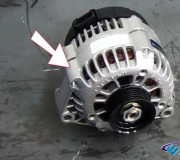You have a common generator failure, nothing more. The problem is though, it's acting up intermittently so any testing has to be done while the problem is occurring.
This has nothing to do with the inspection. GM generators have a very high failure rate, and it's just a coincidence whatever took place just before that last failure occurred. It is just as likely for this to occur right after stopping for gas, right after passing a car, right after getting the oil changed, or right after spilling your coffee in the front seat.
There's two things you need to understand. The first is the "Battery" warning light does not mean the battery is bad. It means the battery is not being recharged by the generator while you're driving. Replacing the battery will only get you going again until that one runs down, which will take less than a half hour, less if you have to restart the engine numerous times, and even less if you run the heater, lights, radio, and any other electrical things.
The second thing relates to this generator. Due to its design, starting with '87 models, these generators develop a lot of huge voltage spikes that can damage its internal diodes and voltage regulator, and interfere with computer sensor signals. The battery is the key component in damping and absorbing those spikes, but as it ages and lead flakes off the plates, it loses its ability to do that. It is real common to go through four to six replacement generators in the life of the vehicle. To reduce the number of repeat failures, replace the battery at the same time unless it is less than about two years old. You already have the new battery, but it's almost certain the fix will be to replace the generator.
Saturday, June 27th, 2015 AT 8:53 PM




